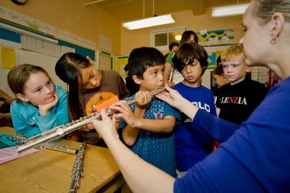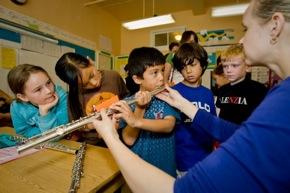Engaging young people in performing or listening to live music is critical to its future survival. And encouraging them to embrace classical music in the age of American Idol comes with a unique set of challenges. Just as music presenters are reinventing the rules in order to reinvigorate waning ticket sales, so must music schools respond creatively to today’s changing demographic and cultural tastes. Successful organizations are searching for innovative solutions to better serve and strengthen their musical communities.
One of them, Community Music Center of Boston (CMCB), is celebrating its 100th anniversary this year, and offering 100 free concerts over 18 months as a “Gift to the City.” “An important factor in our success in creating community comes from our 32-year outreach partnership with the Boston public schools,” says Claudia Haydon, director of development and marketing. The CMCB sends general music and instrument teachers to assist district teachers with their curricula, or to develop new choruses and ensembles. CMCB also runs outreach activities in Boston’s South End, where the organization is located. “A grant from the Linde Family Foundation provides scholarships for the 5,000 students we serve each week out in the Boston public schools to take private lessons or participate in citywide ensembles,” Haydon remarks. To overcome the barriers of its location, the CMCB runs a satellite center in the Boston Latin School, and plans to open more.
Featured Videos
A flip-book tribute to the S.F. Community Music Center
by Anne Hamersky (music by Chus Alonso)
The Boston Community Music Center celebrates
99 Years.
Artistic Director William Fickes emphasizes that his group has diversified the musical genres they teach, and has begun to collaborate with professional groups that connect younger musicians with more experienced ones. “We’ve always offered jazz as well as classical, and world music for the chorus,” he says. “Now we increasingly emphasize the creation of music — both composing and improvising, even using nontraditional instruments, like drumming on buckets.” CMCB students have collaborated on projects with the media lab at the Massachusetts Institute of Technology and the Boston Ballet, allowing young composers the chance to write for the dance medium. “We recently performed [Benjamin] Britten’s Noye’s Fludde together with professionals, which was a great example of how the mentoring experience can immediately inspire our students to rise to the challenge of performing serious repertoire.”
Access for All
In addition to programs in public schools, the MacPhail Center for Music in Minneapolis has developed 64 partnerships with community organizations, touching some 4,500 students (plus the 4,000 attending its own facility). Says CEO David O’Fallon, “Whereas the old model is to use funding for a short-term residency project, for example, our impact comes from investing in mutual partnerships that will last for years and years. These are based on a common responsibility toward each other, and a mission that we both care about.” MacPhail has teamed up with women’s shelters, day care centers, and elder care centers with the goal of having participants “perform, play, make, and share music together.”
One such project is in the Friendship Village, a progressive care facility for elderly people (an expanding segment of the U.S. population). MacPhail started a choir there with a dozen folks, which grew quickly to over 80 members, some of whom asked to form a second, more advanced group. One participant summed up the powerful effect of the musical experience for her: “[The choir director] gave back to me the breath of life.” The public library system of Minneapolis-St. Paul approached MacPhail two years ago, with the idea of providing interactive early-music classes in as many branches as possible. Now, weekly classes are given in over 55 libraries.
Who Pays?
These programs don’t happen without serious funding. In the case of the library partnership, an amendment to the Minnesota State Constitution, allowing citizens to tax themselves to pay for environmental cleanup and the arts and culture, resulted in an influx of tens of millions of dollars into the state’s economy. Says O’Fallon, “This would not have passed if support for the arts had not been linked to support for clean water and wetlands, lobbied for by the state’s recreational outdoorsmen,” a reminder of the power of political partnerships.
Here in budget-stricken Northern California, schools like the Community Music Center (CMC) in San Francisco are working on a smaller scale, yet are no less valiant in their efforts. In a state whose Latino population is the fastest growing, along with a large Asian population, CMC serves around 2,300 students annually, with one branch in San Francisco’s primarily Latino Mission District. It excels in meeting the interests of that community, with quality instruction in Latin styles of music along with strong programs in Western classical music and classes exploring world music. Now they’re taking it a step further, partnering with other nonprofits to run the Mission District Young Musicians Program. CMC Director Stephen Shapiro describes it as “a full scholarship program, for middle and high school students, that focuses on the classical and popular music of the Latin traditions.”
In Oakland, Cantare Con Vivo’s several outreach programs to underserved youth include an award-winning choral program centered at Lincoln High School, which reaches 1,300 students. The choral program, funded by foundation and corporate grants, as well as by individual donations, has been a startling success
Get ’Em While They’re Young

As with any other language, an early introduction to music can inspire a lifelong relationship. When it comes to introducing the youngest set to classical music in a safe, joyful place, Berkeley’s Crowden Center for Music in the Community has a tailor-made opportunity: Babes in arms, up through age 7, enjoy a first opportunity to explore classical music and orchestral instruments at Community Music Day, this Oct. 24 from 10 a.m. to 3 p.m. Community Music Day attracts more than 1,000 people each year, and includes an instrument petting zoo, instrument making, face painting, a barbecue, musical performances by older students, and more. And as if that weren’t enough, the San Francisco Chamber Orchestra provides three sets of its Very First Concerts, a chance to wiggle and dance to the music with no pressure to sit still. Further concerts in this series happen throughout the year at Crowden and elsewhere.
Regardless of size or budget, good community music schools are interested in helping participants realize their musical potential and experience the transformational power of music. According to recent literature by the National Guild for Community Arts Education, “Consistent community engagement is not program based; it is part of organizational culture.” It’s a culture that can only be created by embracing change and inviting two-way interaction.
If You Go:
Community Music Day: Sunday, Oct. 24, 2010, 10:00 a.m. to 3:00 p.m.
Meet the Orchestra Repeat performances at 11:00 a.m., 11:40 a.m., and 12:20 p.m. at Crowden. Strings, woodwinds, and brass are the musical ingredients for the San Francisco Chamber Orchestra in this concert. Do you know the difference between a viola and a trombone? Come and find out.

